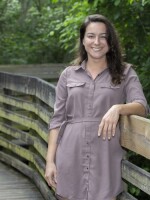Some Florida citrus growers are finally starting to see an increase of orange production. Those who managed to stick around as the greening disease ravaged their groves have been experimenting with different variations of trees, expensive chemicals and fertilizers.
Hear the audio version of this story.
The Durrance family grove is in the middle of the state: Bowling Green, which is in Hardee County. You have to drive down a narrow dirt road sandwiched by citrus trees to get to the large, white house with wrap-around porch. Their living room is well-lit by windows looking out onto the property.
Ian Durrance, 30, is flipping through some old family photos with his dad, Danny. They’re both tall and slightly sunburnt.

"You see how the trees looked then versus the way the trees look now-- how thick they were and all the oranges are uniform? That's what greening does… it makes the oranges just look terrible," Danny said. They don’t even look like oranges anymore. They’re green; they’re just not pretty, like you wanna see an orange."
Danny Durrance was born and raised in this grove that his great grandfather started in the 1800s with just four acres. At their peak, they had about 250 acres, but the citrus greening disease has cut this family’s production in half.
His son, Ian, said the family had to lean on other farm sales to sustain the citrus business.
"If we wouldn’t have had our cattle and our hay, we would’ve had to push up all our grove," Ian said.

But now, like other growers in the state, things are improving. They’re planting new trees that are more resilient to greening. Ian has also been experimenting with better insecticides and fertilizers.
"My son's got a citrus degree from Florida Southern," Danny said. "And when he got to college age I told him, I says, ‘Ian, why do you want a citrus degree? You were born and raised in an orange grove. You’ve been in an orange grove your whole life.’ Well, it's very good that he did that because that is really helping us.'"
Walking through the Durrance family grove, Ian’s eyes scan just about every tree from root to top as he walks by them, and then he stops.
"So this tree, it has greening," he said, pointing to a smaller tree. "That fruit right there will never see the juice plant."
Then he spots Asian citrus psyllids on leaves of the infected tree-- the very insects responsible for greening and the plummet of Florida’s citrus industry.

"Right there… you see that little bug; it's kinda got a blue and a brown wing? That's an adult psyllid. There’s two of them on there. These are nymphs, so you got two life stages right there," Ian said.
He said some neighbors have recently sold their groves to developers because of these insects. In fact, nearly 92,000 acres of planted citrus are gone compared to a decade ago, but this family has no plans to sell.
Back at the Durrance home Ian’s kids are playing with toys on the living room floor.
Ian’s mom, Julie, said she prays to God, asking him to wipe out citrus greening. She said she appreciates her husband’s parents for showing them how to be dependent on God to guide them.
“They believed that God helped get them to where they were. And they gave us a good foundation to build on, and we’re trying to do the same thing,” Julie said.
She's in charge of the finances, and she’s teaching her 27-year-old daughter, Clara, how to do it, too. Clara looks just like Julie—both with small frames and big smiles.
“We've been very blessed and really lucky, me and Ian have, to grow up in this life," Clara said.
Patriarch Danny Durrance hopes to also pass the traditions down to his grandchildren.
"The roots run deep... When you grow up in something and that's what you know and how you live and who you are, then you keep it going," Danny said. "I don’t wanna be the one that citrus goes away from our family."
His grandson Luke is six years old. He said he helped his dad and grandpa around the groves.
"I drive the tractor... the golf cart," Luke said.
Just 30 percent of the growers from 10 years ago are still fighting to stay in the industry. Luke’s family is a part of that. They have faith citrus will still be here when Luke grows up.

Copyright 2019 WUSF Public Media - WUSF 89.7


